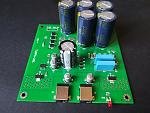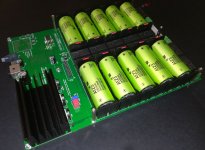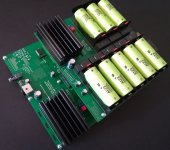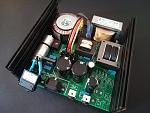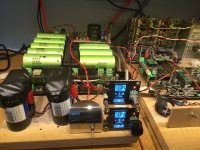TWRPS-LBS-M LiFePo4 batteries power supply main board
Output rails:
- 3V3 to 16V5, typically for oscillators
- 2 x 3V3 to 6V6, typically for DAC
- 3V3, auxiliary devices (for example the clock section of the FIFO)
5V/500 mA linear regulator to supply other devices like USB to I2S and so on
Remote power off
No switching devices or active oscillators during listening
No RF at all (no mulltiplexed display and microcontroller in stad-by mode)
Board size: 260mm x 195mm
Board options: finished and semi-finished
Note: without batteries and battery holders
Output rails:
- 3V3 to 16V5, typically for oscillators
- 2 x 3V3 to 6V6, typically for DAC
- 3V3, auxiliary devices (for example the clock section of the FIFO)
5V/500 mA linear regulator to supply other devices like USB to I2S and so on
Remote power off
No switching devices or active oscillators during listening
No RF at all (no mulltiplexed display and microcontroller in stad-by mode)
Board size: 260mm x 195mm
Board options: finished and semi-finished
Note: without batteries and battery holders
Attachments
TWRPS-LBS-D LiFePo4 batteries power supply daughter board
Output rails:
- 2 x 3V3 to 13V2, typically for DAC output stage
Fit the main board with a single connector
Controlled by the main board
Board size: 184mm x 195mm
Board options: finished and semi-finished
Note: without batteries, battery holders and connectors to stack onto the main board
Output rails:
- 2 x 3V3 to 13V2, typically for DAC output stage
Fit the main board with a single connector
Controlled by the main board
Board size: 184mm x 195mm
Board options: finished and semi-finished
Note: without batteries, battery holders and connectors to stack onto the main board
Attachments
TWRPS-LBS-P LiFePo4 batteries power supply PSU
Output rails:
- linear supply to recharge the batteries
- linear supply to power the FIFO board
- regulated supply to power the oscillators while recharging the batteries, to never shut down the oscillators
Fit the main board with a single connector
Controlled by the main board
Board size: 208mm x 170mm
Board options: bare PCB only
Note: almost all parts are through hole, a few SMD parts only
Output rails:
- linear supply to recharge the batteries
- linear supply to power the FIFO board
- regulated supply to power the oscillators while recharging the batteries, to never shut down the oscillators
Fit the main board with a single connector
Controlled by the main board
Board size: 208mm x 170mm
Board options: bare PCB only
Note: almost all parts are through hole, a few SMD parts only
Attachments
The rectifiers are on board so you don't need DC, use a suitable transformer like the one indicated in the BOM.
Well, I don't want the 50/100/150/200... Hz switching on board. And the magnetic fields.. Better to feed it DC from a long distance (2m?) away. All according to your strategies - right!?
//
Last edited:
You can remove the rectifiers if you want, but IMHO the simplest solution is to put the regulator in a separate box with its transformer and keep it far from the oscillators.
Or better you can use the LiFePo4 batteries power supply to feed all the oscillators and frequency doublers (no swithing devices, no RF at all during listening).
Or better you can use the LiFePo4 batteries power supply to feed all the oscillators and frequency doublers (no swithing devices, no RF at all during listening).
Andrea,the length of the cable between the both will not alter the signal quality of the power supply?You can remove the rectifiers if you want, but IMHO the simplest solution is to put the regulator in a separate box with its transformer and keep it far from the oscillators.
.
I am finding LiFePo4 batteries not the best sounding sources in the analog section. It would be great to be able to stick any other elements in there: for example, Lithium-titanate (2.5V) or ultracapacitors (2.7, 3, 3.3V). As far as I understand, this is only a matter of firmware of the power controller. Am I wrong?
Yes, the threshold voltage is managed in the firmware, but it's not so simple to revise it because it was developed and tested specifically for LiFePo4 batteries (protections and so on).
I would exclude the supercapacitors because they need a different management against batteries.
Anyway, since we are developing a pair of discrete DAC, we are interested on testing alternatives to the LiFePo4 in their analog section.
As soon as the first DAC is ready we will test the Lithium-titanate batteries compared to the LiFePo4.
If they sounds better we could develop one more extra board to manage them controlled by the same main board with a proper firmware revision.
I would exclude the supercapacitors because they need a different management against batteries.
Anyway, since we are developing a pair of discrete DAC, we are interested on testing alternatives to the LiFePo4 in their analog section.
As soon as the first DAC is ready we will test the Lithium-titanate batteries compared to the LiFePo4.
If they sounds better we could develop one more extra board to manage them controlled by the same main board with a proper firmware revision.
OK, got it!
Take into consideration please that the internal impedance of the battery is not a holy grail as many people can claim. In this terms it is more important to listen the exact type of the batterry - pure subjective conclusion is more important (for me at least). I mean - it is not a rule that every example within LiFePo4 or Li-titanate battery should sound the same.
Thank you!
Take into consideration please that the internal impedance of the battery is not a holy grail as many people can claim. In this terms it is more important to listen the exact type of the batterry - pure subjective conclusion is more important (for me at least). I mean - it is not a rule that every example within LiFePo4 or Li-titanate battery should sound the same.
Thank you!
Last edited:
Hi Andrea,
I have been using a lifepo4 battery supply powering your previous clock unit and the fifopi. After I added supercaps in parallel to the batteries I could hear the noise floor dropping very clearly. I think the noise comes from the chemical battery process.
So I would surely advise using supercaps in the power supply of your new clock units, otherwise the benefits of the new design against your previous driscoll design will deminish in the higher noise floor.
Is your battery supply an always on system? I remember you wrote somewhere that it would be best to keep the clocks always on and switch from mains power to battery when listening to music. Is this the way your battery supply is now working?
I have been using a lifepo4 battery supply powering your previous clock unit and the fifopi. After I added supercaps in parallel to the batteries I could hear the noise floor dropping very clearly. I think the noise comes from the chemical battery process.
So I would surely advise using supercaps in the power supply of your new clock units, otherwise the benefits of the new design against your previous driscoll design will deminish in the higher noise floor.
Is your battery supply an always on system? I remember you wrote somewhere that it would be best to keep the clocks always on and switch from mains power to battery when listening to music. Is this the way your battery supply is now working?
Attachments
- Home
- Amplifiers
- Power Supplies
- The Well Regulated Power Supply
